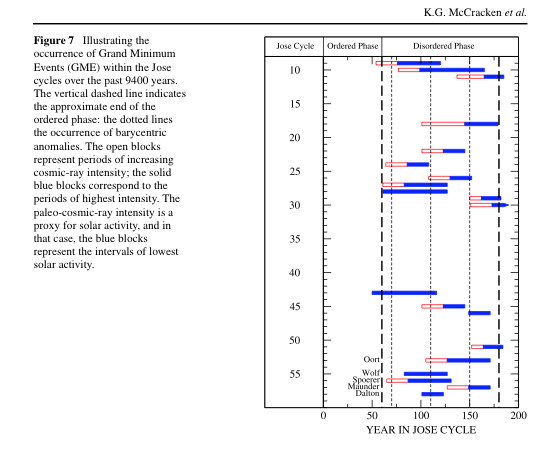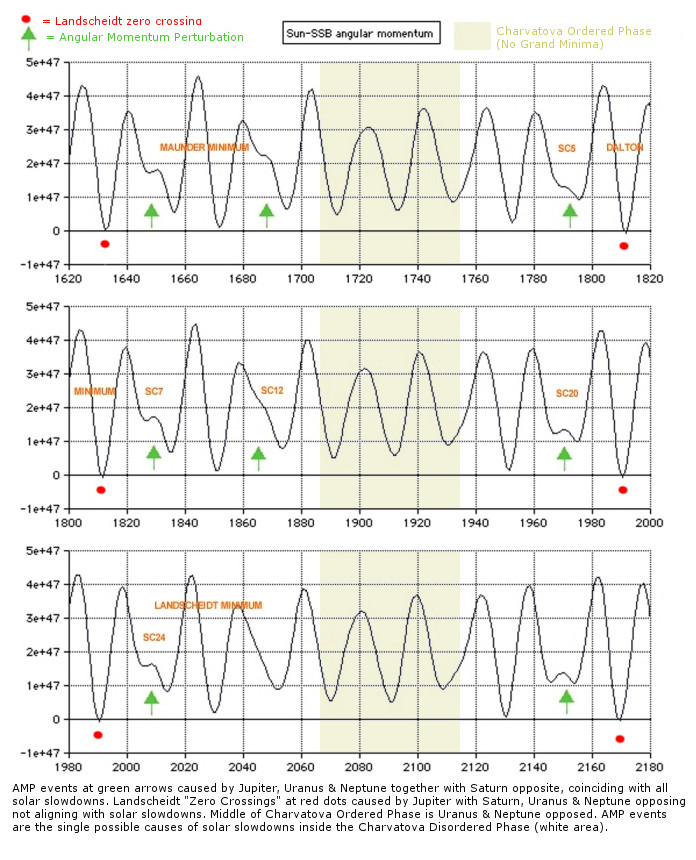|
|
Post by lsvalgaard on Jul 21, 2015 14:11:33 GMT
One part of the reason is that your disordered part is much wider than the ordered part. And why are there no Grand maxima during Jose cycles 30-42? Why do you leave out the last 200 years? Looks like a carefully doctored plot to me.
|
|
|
|
Post by gsharp on Jul 21, 2015 23:22:14 GMT
If the Sun is a random number generator surely we would expect some Grand Minima during the Ordered Phase across the Holocene? Do you know what the Ordered phase is and when it occurs in the Jose cycle?
I assume you mean Grand Minima instead of Grand Maxima during Jose cycles 30-42. If so it is because they basically did not occur (there is a very good reason for this lull in Grand Minima). There were no Grand Minima during the last 200 years and the data and plot is from McCracken et al (2014) published in Solar Physics. If you think its doctored then some proof would be required.
|
|
|
|
Post by lsvalgaard on Jul 22, 2015 14:41:37 GMT
|
|
|
|
Post by gsharp on Jul 22, 2015 22:42:23 GMT
That is hardly an answer to my questions. It seems the great Dr. Svalgaard is stumped? |
|
|
|
Post by gsharp on Jul 25, 2015 4:14:35 GMT
For those that dont understand the McCracken diagram.
The Jose cycle is now 172 years (178.8 years was found to be incorrect).
Each 172 year slice is displayed over the 9400 year 10Be solar proxy record.
McCracken, Beer and Steinhilber are practically the owners of the 10Be ice core records and they have
plotted the position of past solar grand minima during the 172 year intervals (U/N synodic).
If you drew a line down the middle of the Ordered Phase column it would be Uranus and Neptune opposed.
If you drew a line down the middle of the Disordered Phase column it would be Uranus and Neptune together.
The diagram clearly shows that grand minima across the Holocene DO NOT occur 30 years either side of the
Uranus/Neptune opposition. The chances of this occurring at random are near impossible and suggest a planetary
involvement in solar grand minima.
It seems that Dr.Svalgaard has no answer for this?
|
|
|
|
Post by lsvalgaard on Jul 26, 2015 22:11:28 GMT
There is no Jose cycle the last 400 years, and the whole hypothesis is debunked here: www.researchgate.net/publication/259743078_Critical_Analysis_of_a_Hypothesis_of_the_Planetary_Tidal_Influence_on_Solar_Activity"The present work is a critical revision of the hypothesis of the planetary tidal influence on solar activity published by Abreu et al. (Astron. Astrophys. 548, A88, 2012; called A12 here). A12 describes a hypothesis that planets can have an impact on the solar tachocline and therefore on solar activity. We checked the procedure and results of A12, namely the algorithm of planetary tidal torque calculation and the wavelet coherence between torque and heliospheric modulation potential. We found that the claimed peaks in long-period range of the torque spectrum are artifacts caused by the calculation algorithm. Also the statistical significance of the results of the wavelet coherence is found to be overestimated by an incorrect choice of the background assumption of red noise. Using a more conservative non-parametric random phase method, we found that the long-period coherence between planetary torque and heliospheric modulation potential becomes insignificant. Thus we conclude that the considered hypothesis of planetary tidal influence on solar activity is not based on a solid ground." Why keep beating a dead horse. |
|
|
|
Post by gsharp on Jul 27, 2015 1:19:56 GMT
Much confusion going on here. The rebuttal paper you mention is for Abreu et al (2012)(McCracken a co-author). The diagram in question is from McCracken (2014) and is a totally different theory. The McCracken paper (2014) and my paper (Sharp ,2010) are the same theory and so far unchallenged. So instead of offering false leads, could you answer the question? Why do all solar grand minima of the Holocene occur in the right column (Disordered Phase) and never in the left column (Ordered Phase)?  Also your statement below makes no sense. "There is no Jose cycle the last 400 years"
I am not sure you understand what the Jose cycle is? |
|
|
|
Post by gsharp on Jul 27, 2015 7:30:04 GMT
|
|
|
|
Post by gsharp on Jul 28, 2015 4:51:19 GMT
Gsharp, You said..."If the Sun is a random number generator surely we would expect some Grand Minima during the Ordered Phase across the Holocene?" Why? If the Sun is random why should it have order? Why, mathematical, does randomness have to have a prediction of order? As I understand the study of random events..."the mathematical theory of probability deals with patterns that occur in random events" and are you not assuming a measurement of certainty exists ("surely we would expect") but based on a value of chaos? Random events are not certain. I would love those odds on the roulette wheel. I could bet a certain event would not happen for 1/3rd of the total casino opening time (ie between say 9pm and 3am if open 24/7). I think you are missing the point. Over the entire Holocene Grand Minima do not occur in a recurring 50-60 year window (which is around 1/3rd of the total time). This suggests some kind of controlling influence, as it would be unreasonable to suggest this could happen by chance alone. The Bablock/Leighton model has no answer for why Grand Minimia do NOT occur during the Ordered phase, the NEW planetary theory does, and is completely falsifiable. |
|
|
|
Post by gsharp on Jul 28, 2015 22:59:47 GMT
New planetary theory is totally falsifiable, solar grand minima cannot occur when Uranus and Neptune are opposed and can only occur when Uranus, Neptune and Jupiter are together with Saturn opposed (green arrows).  www.landscheidt.info/images/sunssbam1620to2180gs.jpg www.landscheidt.info/images/sunssbam1620to2180gs.jpg |
|
|
|
Post by gsharp on Jul 31, 2015 15:52:35 GMT
The green arrow tells it all...2150 and it will be very weak. Forget about any talk of a new little ice age. The next 1000 years will see no major grand minima, we have left that zone now.
|
|
|
|
Post by acidohm on Aug 1, 2015 20:17:57 GMT
The thing i most love about all this conjecture is......we dont have to wait THAT long to find out whos right!!
|
|
|
|
Post by gsharp on Aug 7, 2015 23:42:50 GMT
The green arrow tells it all...2150 and it will be very weak. Forget about any talk of a new little ice age. The next 1000 years will see no major grand minima, we have left that zone now. Gsharp, Aside from yourself are there others who hold your position minor outer planets control solar sunspot activity? Your prediction "The next 1000 years will see no major grand minimais" does not allow for the Sun itself to decide what it will do and that is a oversight. Let me share a story: An acquaintance, Rick, is well educated man with both an MD and a PhD in physics. The last project I knew he was working on was a model to predict future heart problems based on current normal (what is normal?) cardiac rhythms. You see current science has no model for the human heart beat and if we looked at a dozen different rhythms we would have no way of predicting future outcomes aside from obvious abnormal arrhythmia. Rick's efforts with a work group at the University of Washington Medical Center was to develop a mathematical expression to do just that. My wife and I ran into that question for a number of years when we visit our child's classroom with a portable EKG machine to make a printout of each child's heartbeat. Our purpose was fun with the intent to show each child what their own heart beat looked like on paper but we discussed what we would do if we encountered an arrhythmia? How should we proceed? How should we tell the parent of that child they had potentially life threatening condition? We were fortunate in that we never once had the concern arise. Back to the sun: While your model predicts no grand minima for the next 1000 years I think you should ask the sun what it intends to do. It may care little what the planets think. Code McCracken, Beer & Steinhilber published in Solar Physics in May 2014 with the exact same theory as my own. www.landscheidt.info/?q=node/325The Sun does not decide what to do, it is at the mercy of the planetary forces and cycle timing. This has been shown across the whole Holocene. Your comments suggest you have not understodod my paper...don't worry, very few do. SC24 is a real time current example of the theory, so we don't have to wait. |
|
pavel
New Member

Posts: 12 
|
Post by pavel on Nov 11, 2015 9:04:51 GMT
DR. L.Svalgaard...as it is very possible that during weak solar cycle 25, at solar disk will appear big coronal hole at the sun's equator. Could it be the cause of the next Carrington event.In fact, records show that auroras continued to appear on a regular basis even during the Maunder Minimum. Next question: is the absence of toroidal flow (torsional oscillation) responsible for the occurrence of cycle 25 is a reliable indicator of the nature of cycle 25.The actual delay from what I know, is more than five years.Does this mean that we will have a prolonged minimum or even the lack of cycle 25.  |
|
|
|
Post by lsvalgaard on Nov 18, 2015 4:59:28 GMT
We think that a Carrington-type event might occur at any phase of the cycle, with the possibly exception of the year of solar minimum.
The torsional oscillation has returned to 'normal' so there will be a cycle 25. Also the solar polar fields are now strong enough [especially in the south] to suggest that cycle 25 will be about as strong as cycle 24, and thus not 'superweak'.
|
|